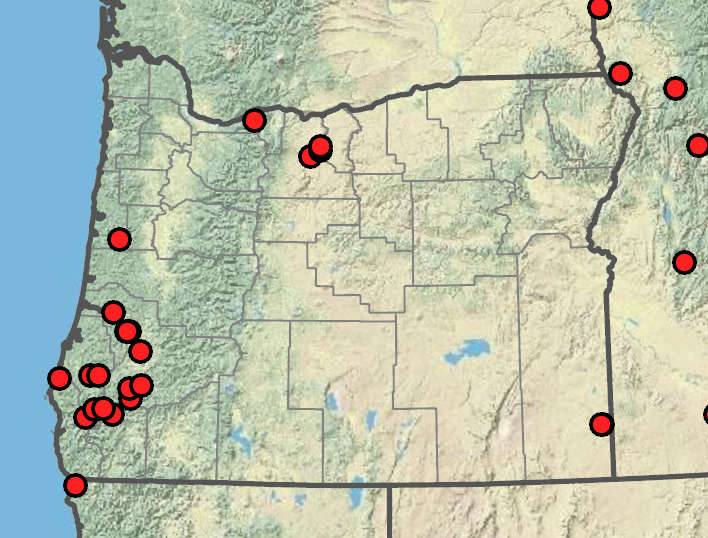Muhlenbergia mexicana
(synonym of Muhlenbergia glomerata)
Muhlenbergia filiformis
wirestem muhly
pull-up muhly
0.5–2 mm thick; much branched above the base, not nodulose;
internodes dull, puberulent or glabrous for most of their length, sometimes strigose immediately below the nodes.
often rooting at the lower nodes, not nodulose;
internodes glabrous.
blades 2–20 cm × 2–6 mm; flat, scabrous or smooth, those of the secondary branches similar in length and width to those of the main branches.
blades 1–4(6) cm × 0.6–1.6 mm; flat or involute; lower/outer surface smooth or minutely scabrous; upper/inner surface scabrous or pubescent.
terminal and axillary, 2–21 × 0.3–3 cm; dense, appressed or diverging up to 30° from the inflorescence axis;
primary branches 0.3–5.5 cm × over 0.1 mm.
spike-like, 1.6–6 × 0.2–0.5 cm, interrupted near the base; long-exserted from the upper leaf sheath;
primary branches 0.9–1.2 cm ×over 0.1 mm, appressed at maturity or diverging 30(40)°;
pedicels 1–3 mm, scabrous.
1.5–3.8 mm, often purple-tinged.
1.5–3.2 mm.
subequal, 1.5–3.7 mm, approximately as long as or slightly shorter than the lemmas, 1-veined, tapering from the bases to the acuminate tips; awnless or awned; awns; if present; to 2 mm.
greenish gray, glabrous, 1-veined, rounded to subacute;
lower glumes 0.6–1.4 mm;
upper glumes 0.7–1.7 mm;
tips rounded to subacute.
1.5–3.8 mm, lanceolate, pubescent on calluses and lower portion of the midveins and margins;
hairs shorter than the florets; less than 1.5 mm long;
tips minutely scabrous, acuminate; awnless or awned;
lemma awns 0–10 mm.
(1.5)1.8–2.5(3.2)mm, lanceolate; dark greenish, appressed-pubescent on the margins and midveins;
hairs shorter than 0.3 mm;
tips minutely scabrous; acute to acuminate; awnless, sometimes with small points at the tip.
0.3–0.5 mm; yellowish to purplish.
0.5–1.2 mm; purplish.
=40.
=18.
Muhlenbergia mexicana
Muhlenbergia filiformis
Throughout North America. 2 varieties.
Muhlenbergia mexicana flowers relatively late in summer after river levels drop. It is seldom collected. The similar M. andina has lemma hairs about as long as the lemma body.
Moist meadows, lake shores, stream banks. 100–2800m. BR, BW, Casc, ECas, Sisk. CA, ID, NV, WA; north to British Columbia, east to NE, south to Mexico. Native.
Muhlenbergia filiformis is a tiny, delicate annual usually about 5 cm tall, with a narrow, purplish inflorescence. It may form dense, turf-like stands. It often grows with similar M. richardsonis, a more robust, more or less rhizomatous perennial with nodulose stems and glabrous lemmas. This species gets its common name of “pull-up muhly” because cattle pull up clumps of the short plants but cannot manipulate them to eat them and thus drop the tufts on the meadows.
Barbara Wilson, Richard Brainerd, Nick Otting
Barbara Wilson, Richard Brainerd, Nick Otting
- Local floras:
BC,
OR,
WA
- Local Web sites:
Flora NW,
PNW Herbaria
WildflowerSearch
iNaturalist (observations)
USDA Plants Database
- LBJ Wildflower Center
- SEINet
- Plants of the World Online
- Encyclopedia of Life
- Wikipedia
- Google Image Search
- Local floras:
BC,
CA,
OR,
WA
- Local Web sites:
CalFlora,
CalPhotos,
Flora NW,
PNW Herbaria
WildflowerSearch
iNaturalist (observations)
USDA Plants Database
- LBJ Wildflower Center
- SEINet
- Plants of the World Online
- Encyclopedia of Life
- Wikipedia
- Google Image Search




